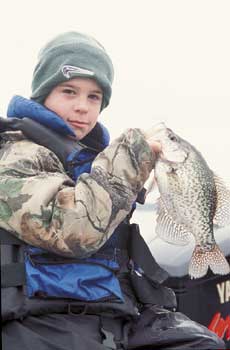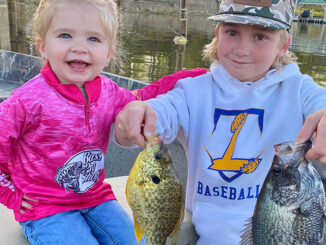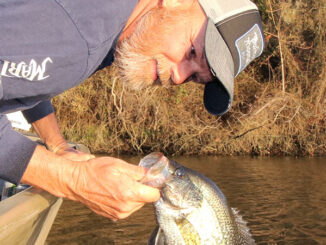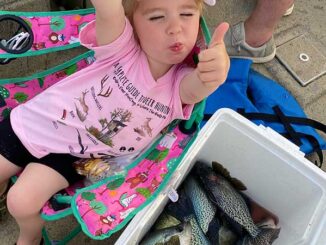
By trade and profession, I’m a bass fisherman, but that doesn’t mean bass are the only fish I like to catch.When the winter approaches and bass get sluggish, it’s not hard for me to change gears and start fishing for crappie. I do that for fun, and it’s a great thing to do with my kids or just for some rest and relaxation for myself. And crappie are some really good eating, especially in the winter when the water temperatures are fairly low. They fry up real good in the winter.
But bass fishing and crappie fishing go hand-in-hand, at least where I’m concerned. Here at Lake Murray, my home lake for years and years, I’ve been able to catch nice stringers of crappie by fishing around brushpiles I’ve put out to attract bass.
I think the neat part of my deal is that I usually put out my brush piles in November and December, and I’ve found crappie will move to them a lot faster than bass. I’ve actually put ’em out one day and come back the next day and caught crappie at ’em.
When I’m putting out brush, I like to use hardwoods — sweet gums if they’re available. They’re probably my favorite kind of tree to put out. A lot of people consider them a nuisance, and they don’t mind you cutting them. Plus, they have a lot of limbs and they grow out real nice and rounded.
Since I’m putting them out in November and December, the leaves are all gone. I normally sink ’em to the bottom two different ways. I’ll lay ’em out on their side by tying some cinder blocks to the base of the tree and up toward the top, tied off with wire. But if I’m putting them out in deep water, I’ll normally try to stand ’em up on end.
I’ll put the blocks all at the bottom and maybe tie some plastic jugs up toward the top in the branches to help them stand up.
When I get ready to put them out, I try to look for a certain kind of place to put them. I’m really partial to the inside or outside bend of a creek or river channel where the brush can be closer to deep water.
If the water is 20-feet deep or more, I’ll stand ’em up. If it’s shallower than that, or if you’re around a good bit of current, I’ll lay ’em down.
You almost have to lay ’em down if you’re around any kind of current, because the current will move ’em around an awful lot, and it may wash them out into the channel, where it falls off into really deep water and is pretty useless. And it doesn’t take a lot of current to move a big old tree if you don’t have a lot of weight on it.
There are times when I’ll stand some brush in shallow water, and when I do that, I might use a small tree, or I’ll cut some cane along the river bottom, put it in a 5-gallon bucket, pour in some Quik-Crete concrete mix and let it set up. You can drop it down and locate it fairly easily.
When it comes to crappie fishing, the trees that are standing up are the ones that really attract more fish. Those tend to be the ones you can use year-round, because the crappie will suspend up in the limbs even more than bass will.
You can have a tree standing up, maybe 18-feet tall, and you’ve got it in 23 or 25 feet of water, and the fish will spend a lot of time around that kind of tree. They can suspend up about 18 feet off the bottom, or maybe down 10 or 12 feet from the surface, or they can be all the way to the bottom.
I can put brush piles out one day and catch crappie off ’em the next day maybe, but certainly within a week.
As far as the way I fish, I usually go at it one of two ways. I love to use ultra-light spinning tackle and cast to the trees. I like a 4 1/2- to 5-foot All-Star rod and a Pfleuger Presidential spinning real spooled with either 4-pound or 6-pound Berkley Sensation line.
I like to fish a 1/16-ounce crappie jig, a tube jig, although I’ll fish an 1/8-ounce jighead depending on the depth and wind. It’s hard to use that 1/16-ounce jig during a windy day.
What I do is cast to the brush pile and count the jig down. I need to find out where the fish are suspended around the tree.
A lot of time your fish may be suspended in 18 feet of water, but they’ll be only 4-feet deep. So my first cast, I usually count down to about three, then bring it back real slow. My next cast, I’ll count down to five, then the next time to about seven.
Once you get a bite, that’s how much you count down every time because all of the crappie at that brush pile usually will be within a couple of feet of the same range.
It’s important to pay attention to your countdown because it’s much harder to find crappie near brush piles and trees with your depth-finder because the limbs and jugs tend to show up on the LCD and not the fish.
The other way I like to fish is to tight line with a rod and reel or a fiberglass crappie pole.
I’ll get right over a tree or brush and fish vertically, and I’ll fish two ways. If I’m fishing deeper brush, or if I have a little wind and maybe some rough water, I’ll fish straight down with a buckshot-size piece of lead you can squeeze on over the hook, so you’re tight-lining with nothing but a hook and a minnow under that.
If I can get away with it, I’d prefer to use a 1/16- or 1/32-ounce leadhead and hook a minnow through the lips.
When you do that, you can let that minnow free fall down through the brush, and it’s a more natural approach; it seems to do a lot better. But the more waves you have, the tougher conditions, a tight line is the most secure way to fish and keep your bait in front of the fish.
You can catch crappie at brush piles like this for most of the winter, and when it finally warms up in the spring, the brush is ready to hold those bass you intended it to all along.
Davy Hite is a 40-year-old native of Saluda, who resides at Ninety Six. He has fished professionally since 1993 when he qualified for his first Bassmasters Classic. He was the BASS Angler of the Year in 1997 and 2002, won the 1999 Bassmasters Classic and the 1998 FLW Tour Championship. He is sponsored by Triton boats, Evinrude outboards, All-Star rods, Pfleuger reels, Pure Fishing (Berkley), Owner hooks and Solar-Bat sunglasses.




